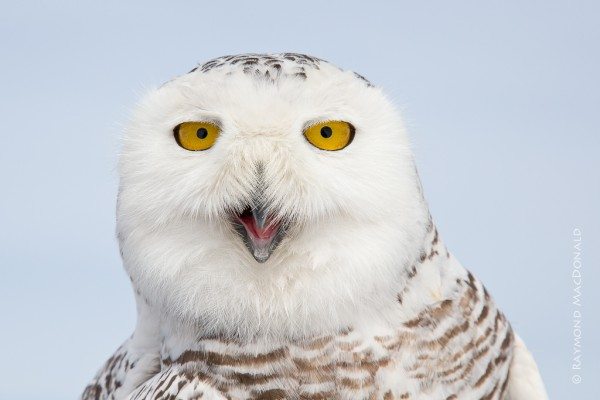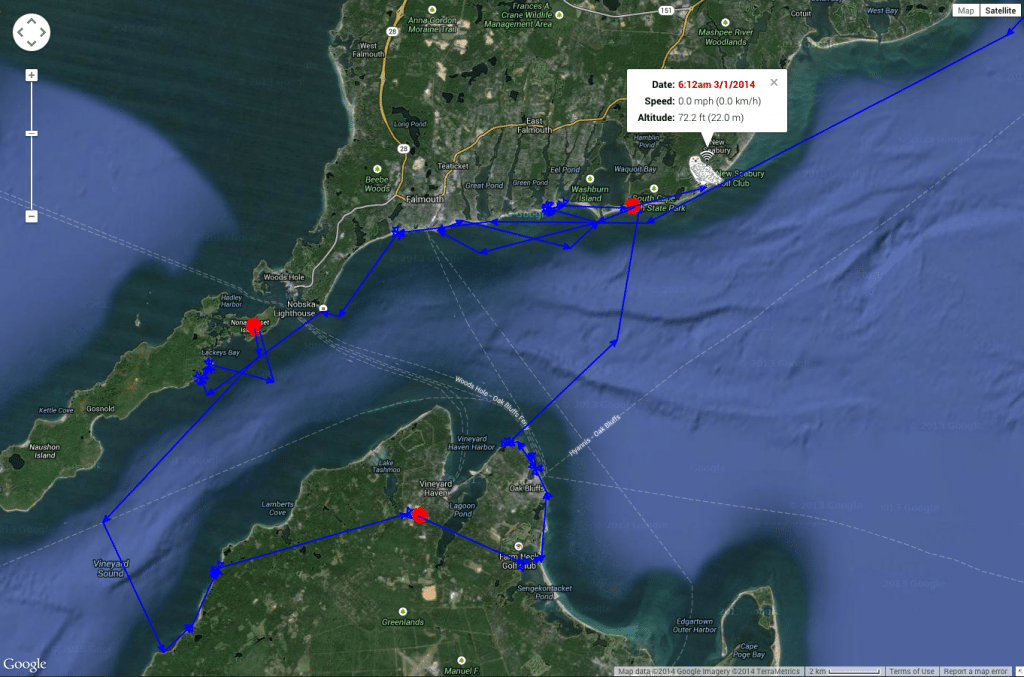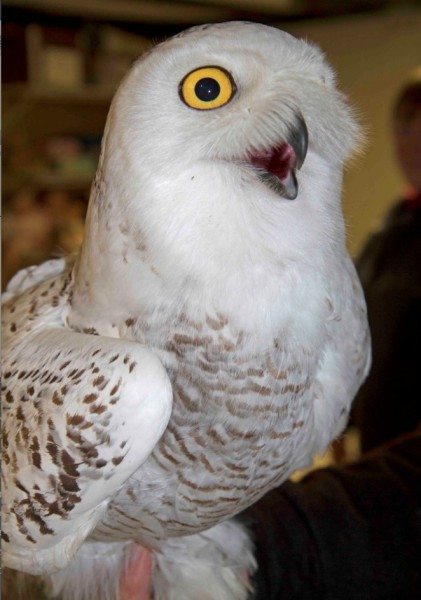I apologize for the lack of updates the past week. It’s been an incredibly busy one, with a few unexpected wrenches and some great news balancing out each other. This will be a long update.

“Plum,” the newest tagged owl in Massachusetts, relocated from Logan Airport to Plum Island NWR on Tuesday. (©Ray MacDonald)
The biggest news is that we completed our Indiegogo campaign this week at $36,663 — 183 percent of our original goal. We’re still gobsmacked by the response, and grateful for the tremendous public support for Project SNOWstorm.
The other big news is the addition of two more tagged owls — “Womelsdorf,” in eastern Pennsylvania, an immature male that I tagged Monday night, and “Plum,” an immature female that Norman Smith relocated yesterday from Logan Airport in Boston to Plum Island National Wildlife Refuge in northeastern Massachusetts.
Gene Jacobs was trapping in Wisconsin this past week, but after being skunked by one owl, he trapped a second, only to find it thin and suffering from a wing injury. That bird is now at a rehab facility, which concluded the injury was from an electrical shock — an often fatal occurrence with large raptors whose wings are wide enough to bridge the space between electrical wires. Hopefully this owl will recover well enough for release.
We continue to delay updating maps by at least three days as a safety precaution for the owls, a policy that took on added importance last weekend when a falconer in Pennsylvania tried to trap a group of several snowy owls that included Amishtown, one of our tagged birds.
Pennsylvania does not restrict the capture of snowy owls by appropriately licensed falconers, although few falconers want an owl of any species, much less a snowy. Still, it caused an incredible ruckus. The president of the largest falconry group in the state has reached out to the falconer in question and urged him to cease his attempts to catch a snowy owl, which we’re told he agreed to do. But there has been at least one other case this winter of a falconer in Wisconsin capturing a snowy owl, and federal regulations apparently would not prevent someone with the necessary falconry permits from taking even a banded, tagged owl.
(This is not a smack against falconry — in fact, SNOWstorm includes one or two falconers among its main researchers. We’re not looking for a lot of comments bashing falconry. Most falconers were as appalled by the news as we were, and the incident has prompted an effort to work collaboratively to tighten Pennsylvania’s falconry regs to prevent such problems in the future.)
For the most part, the tagged owls that have checked in over the past week are doing what they’ve been doing (and where they’ve been doing it) all winter. We’ll have fresh map updates tomorrow for the period March 1-3. But here’s a synopsis of what’s been happening:
Erie continues to wander around Lake Erie, showing a lot of affinity for the northern shore east of Long Point, Ontario. Millcreek is apparently out of cell range yet again, last seen heading out into the central part of the lake Feb. 27. There is an increasing amount of open water cracks in the ice, providing good hunting grounds for waterfowl.
Amishtown, after his near-brush last weekend, has been all over Lancaster County, moving up to 12 miles almost down to Conestoga, then back up toward New Holland again.
In New York, Cranberry hasn’t checked in since Feb. 15, and his transmitter was showing some recharging issues; Tom McDonald in Rochester reports that it’s been persistently cloudy up there, but the bird could also be offshore far enough to be out of cell range. Braddock, on the other hand, has been moving back and forth between Monroe and Orleans counties, sometimes onshore, often offshore near the shrinking ice edge.
Along the New Jersey coast, Assateague and Henlopen have been holding to their respective stomping grounds on lower Barnegat Bay and the southern end of Long Beach Island. Farther north, Duxbury missed the last check, but had been along the Massachusetts coast near Winthrop — worryingly close to Logan Airport, where she was originally trapped last month. We hope she stays away from there.

Sandy neck’s movements last week, crossing Vineyard Sound a couple of times between Cape Cod and the islands. (©Project SNOWstorm)
Sandy Neck, on the other hand, has remained well to the south, flying out to Naushon Island and then to Martha’s Vineyard, crossing that island and then coming back across the sound to Cape Cod again. She’s making nocturnal flights over the bays and sounds, but they don’t look like the kind of habitual hunting flights we see with Assateague — she crosses water on her way somewhere.
In Wisconsin, Buena Vista continues to check in sporadically from his longtime location in the Buena Vista Grasslands. The folks at CTT were able to push through a new transmitter program on March 1, which if it loads properly will bring his unit in line with the duty cycle we’ve been using on the other transmitters with much more success.
Also in Wisconsin, Kewaunee is hanging tight to his territory close to the edge of Lake Michigan — but not on the lake, since the western shore has remained ice-free this winter. Freedom checked in March 1 with a limited number of locations, but enough to show that she’s remaining south and east of town.
Finally, Ramsey remains probably the most predictable owl in the stable, habitually hunting the same “COR” area (as it’s known) of the town of Ramsey, MN, using hotels, highway lights and street signs as his hunting perches.
The one mystery bird right now is Hungerford, the young female banded on Assateague Island last month that made a rapid flight up the Delmarva and into Lancaster County, Pa. Her transmitter hasn’t checked in since Feb. 24, and while it could easily be a transmission or battery issue, we’re hoping there’s not a more serious problem at play, like a vehicle collision. Keep your fingers crossed.



25 Comments on “The Good, the Bad and the Ugly”
So glad Amishtown is still free. I had no idea this would be another threat for them. Glad it is being handled.
Not only that. Four women stopped their car, got out and one climbed a snow bank, walked across the snowy field clapping her hands and waving her arms in the air to scare the owl away while it was feeding…
As it happened, this morning Dr Mark Avery, formerly Conservation Director at the RSPB and now perhaps the UK’s foremost freelance blogger, wrote about Snowy Owls (http://markavery.info/2014/03/04/snowy-owls-birdwatch/) so I took the opportunity to post a comment about SNOWstorm. I hope this has brought a few more international followers of this amazing project.
Thanks for the shout-out from the UK, David — and very nice of you to mention SNOWstorm in Dr. Avery’s well-respected blog. Mark is missing the chance of a lifetime to see a snowy owl over here.
I just recently signed up to receive these e-mails, and really appreciate the update! It happens, we live near Barnegat Bay, and plan a trip soon to see if we can spot Henlopen! If we are able, we will take a photo, but of course, we know that could prove difficult. Thank you for this new update!
Thanks for posting this. I was worried about Amishtown, and am happy to see the Falconry community step up on this case. I looked at New York’s Falconry regulations and they seemed well thought out and sensible (limited take seasons and ages), and I know that the majority of this pursuit is filled with people who genuinely love and care for these wonderful birds. I’d love it, though, if banded/tagged birds were subject to immediate release as subjects in a viable scientific study – although the birds would be well cared for by the falconers, their scientific value would be negated. Better for the bird is, unfortunately, not always better for the species.
Hey Scott! I am Steve’s daughter. My name is Rowan. Just want to say this owl reasearch has been fun, I hope it never ends! He caught me Hungerford down in Asseteague. As you may have have known. Hungerford is my birthday owl. So, I also want to lastly say these owl pictures you are postng are amazing!
You’re a lucky girl to have a dad who does such cool stuff, Rowan. And besides, someone has to pick up the torch when your dad (and the rest of us) are too old for this kind of carrying-on.
Yep. I am someday going to be up at the saw whet station saying ” Where are all those lemmings?” :-)
I recently came across members of your field team in Marshfield, Wisconsin. In fact the owl they had captured was on our property. I just wanted to verify that the owl was going to be returned to this area after the transmitter is attached. You have a cool program here and look forward to following this owl and also your others.
That was Gene Jacobs from University of Wisconsin-Stevens Point, one of our collaborators (and who tells me they had actually caught the bird on a nearby property). Once they had the immature female owl banded, processed and tagged, they brought her back to the capture site around sunset and let her go. We’ll have more information about “Marshfield,” our 18th tagged snowy this winter, posted soon.
Hi Jay,
This is Gene Jacobs from UWSP, I took a drive to Marshfield and found our owl sitting on the transmission line pole, a couple hundred yards NW or your property. She looks fine and doing well.
That’s great Gene. That means job well done. When do you anticipate the tracking map being on the website?
Possibly sometime tomorrow, if she connects to the cell tower ok.
Hi Jay,
In case you didn’t notice, the first set of maps are online for our Marshfield Snowy.
When you say an owl hasn’t checked in, does this mean no communication from the transmitter or no movement? How would you know if the owl was harmed v. a problem with the equipment? Also do you go to the last check in location to see if you can figure anything out?
“Checking in” is our shorthand for whether a transmitter connected via the cell network and transmitted data. The transmitters are programmed to do that once every three days, generally just after dark when the owls are up and active. A missed check-in can be because the owl was out of cell range or in a dead zone, or because its transmitter had fallen below a minimum voltage threshold, which can happen if there’s been a string of cloudy days. If it misses, the transmitter waits another three days to try again. Those sorts of things happen fairly often, so we tend not to panic when an owl misses a couple of check-ins. For instance, Freedom (north of Appleton, WI) had missed two check-ins since Feb. 26, but checked in unexpectedly yesterday and appears to be just fine. And the new duty cycle for Buena Vista has made a huge difference in battery performance, and we got a nice data download from him on March 6.
These transmitters sound very unreliable. With the lack of check in makes me think there is more danger for the owls than it is worth. It is my understanding that biologists have little concern for the life of the wildlife they are studying, because their work is more important than a loss of a few lives.
You couldn’t be more wrong, on several counts. The welfare of the owls is and remains our top priority, which is why we’re using an approach with a proven safety record with snowy owls — backpack harnesses made of low-rub tubular Teflon ribbon, with transmitters that weigh less than 3% of the owl’s total mass. This approach, using satellite transmitters, was tested by scientists from Laval University in Montreal on breeding snowy owls. They found no differences in either survival rates or breeding success between tagged and untagged owls. (Therrien et al 2012. “Survival and reproduction of adult snowy owls tracked by satellite,” Journal of Wildlife Management 76:1562-1567.)
The transmitters have actually been extremely reliable, despite the limitations of using a solar power source on a nocturnal bird. Even when a transmitter fails to connect during its once-every-third-day cycle, it continues to log data, which is stored until the next cycle. With a storage capacity of 100,000 GPS locations, it could store up to 5.7 years’ worth of data before the memory chip fills up. When it’s in range of a cell tower, it downloads. For example, Hungerford, who last transmitted Feb. 26 in central Pennsylvania, downloaded 10 days’ worth of data today — a remarkable trip from Lancaster County to the area around Stone Harbor, NJ, where she is now.
Will the tracking devices, that you “backpacked” on Snowys in the USA track them in the Canadian Arctic?
Yes, the transmitters are solar-powered and will continue to log GPS locations indefinitely. As programmed now, they take a location every 30 minutes, and have a storage capacity at that rate of 5.7 years, although we can reprogram remotely to a different duty cycle before they head north. If in subsequent years the bird comes within cell range anywhere in the world — including an increasing number of cell-equipped villages and towns in the Arctic — the transmitter will send a text message with the accumulated data. Because the units are solar-powered, if an owl winters in the Arctic the transmitter will eventually go into sleep mode once 24-hour winter darkness sets in, but it will come out of hibernation in the spring and resume collecting data. Although we designed this study to focus on wintering behavior and habitat use in the lower 48, getting incredibly detailed information about breeding-season movements in the Arctic would be a huge additional benefit.
Gene, I took a quick spin this morning and spotted Marshfield. She looks to be doing great. And this nice sunshiney day should be great for a good thorough charging of her solar panel, correct? Let me know if there is something I can do on the Marshfield end of the project.
Do you have any indication on what is the status of Cranberry? It has been a couple weeks since last record.
We don’t, but given all four of our Great Lakes birds’ tendency to head out onto the ice for long stretches, we’re not too concerned. Millcreek on Lake Erie has also been AWOL for almost as long, last detected heading north from Ashatbula, OH, along the fractured western edge of the ice sheets. And in the past two weeks, most of eastern Lake Ontario froze up in an interlocking mass of giant ice sheets — the lake’s mostly be under clouds lately, but here’s the image from March 7: http://coastwatch.glerl.noaa.gov/webdata/cwops/html/modis/modis.php?region=o&page=1&template=sub&image=a1.14066.1828.LakeOntario.143.250m.jpg. We suspect that Cranberry’s just well offshore and out of cell range.
Hi Gene. Yes, I did see that. I take a ride 3 times a day and see her almost every time and everyday. Thanks for the head’s up. Jay